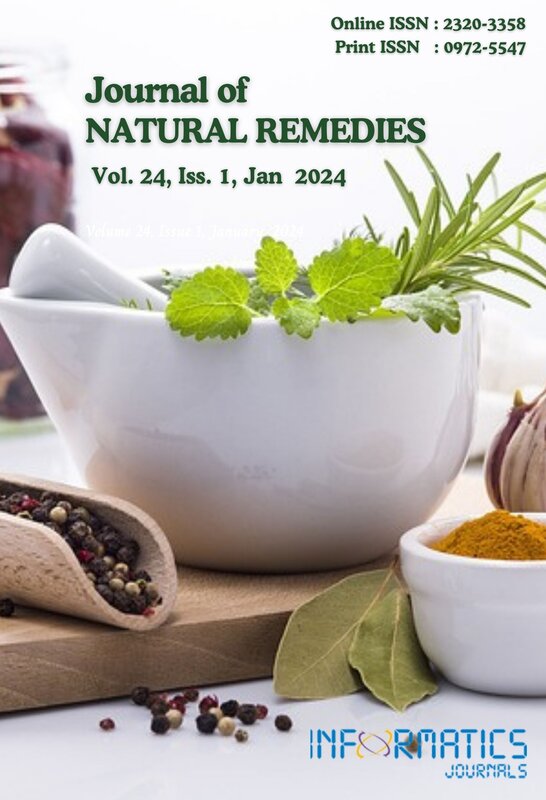An In Vitro Study for Evaluating the Antimicrobial Efficacy of Polyherbal Combination Against Escherichia coli in the Management of Mutrakrichra (Urinary Tract Infection)
DOI:
https://doi.org/10.18311/jnr/2024/34473Keywords:
Anti-bacterial Activity, Berberis aristata, Emblica officinalis, Escherichia coli, Honey, Mutrakrichra, Urinary Tract InfectionAbstract
Millions of people worldwide experience Urinary Tract Infections (UTIs), which rank among the most widespread bacterial infections. UTIs are a common health issue, particularly among women and certain populations. Escherichia coli is the most frequent pathogen, causing 75-90 % of UTIs. Timely diagnosis, appropriate treatment, and preventive measures can help reduce the burden of UTIs and minimize complications associated with these infections. In order to address this issue, classical formulations are mentioned in Ayurvedic texts. In the current study, hydroalcoholic extracts of Emblica officinalis (Amalaki) and Berberis aristata (Daruharidra) were prepared. The antimicrobial activity of the extracts and their combination was evaluated by establishing their Minimum Inhibitory Concentration (MIC) and measuring the zone of inhibition. The combination of Amalaki and Daruharidra with honey shows significant inhibition of E. coli which is comparable with tablet Norfloxacin. This study suggests that Emblica officinalis (Amalaki) and Berberis aristata (Daruharidra) can be used in Mutrakrichra associated with Mutradaha in the context of urinary tract infections.
Downloads
Metrics
Downloads
Published
How to Cite
Issue
Section
License
Copyright (c) 2024 Thakral Vidhi, Karkare Manjusha, Bhagat Lumi, Mathad Prasanna, Patel Janki (Author)

This work is licensed under a Creative Commons Attribution 4.0 International License.
Accepted 2023-09-20
Published 2024-01-01
References
Bono MJ, Leslie SW, Reygaert WC. Urinary Tract Infection. (Updated 2022 Nov 28). In: StatPearls [Internet]. Treasure Island (FL): StatPearls Publishing; 2023. Available from: https://www.ncbi.nlm.nih.gov/books/NBK470195
Yash Pal Munjal, India. API textbook of medicine. 10th ed. Mumbai: Dr. Yash Pal Munjal. for and on behalf of the Association of Physicians of India, New Delhi; 2015. Chapter - 7, p. 1791.
Sastri Kasinath, Chaturvedi Gorakhnath, Charaka Samhita of Agnivesh Part-1. Varanasi: Chaukhambha Bharati Academy; 2023. Vimansthana, Chapter 5, p. 633, 635.
Shastri Ambikadatta, Sushruth Samhita part-2, Uttartantra, Chaukhambha Samskrit Sansthan Varanasi, Chapter-59, p. 549-552.
Sastri Kasinath, Chaturvedi Gorakhnath, Charaka Samhita of Agnivesh Part-2. Varanasi: Chaukhambha Bharati Academy; 2022. Chikitsasthana, Chapter 26/53, p. 662.
Sharma Komal, Berberis aristata: A Review International Journal of Research in Ayurveda and Pharmacy. 2011; 2(2):383-388. https://www.researchgate.net/ publication/215483150_Berberis_aristata_A_Review
Kosalec I, Jembrek MJ, Vlainić J. The Spectrum of Berberine Antibacterial and Antifungal Activities. Promising Antimicrobials from Natural Products. 2022; p. 119–32. https://doi.org/10.1007/978-3-030-83504-0_7 DOI: https://doi.org/10.1007/978-3-030-83504-0_7
Sharma Priyavarta. Dravya Guna Vigyan. Vol. II. Varanasi: Chaukhamba Bharati Academy; 2005. p. 458.
Kumar A, Tantry BA, Rahiman S, Gupta U. Comparative study of antimicrobial activity and phytochemical analysis of methanolic and aqueous extracts of the fruit of Emblica officinalis against pathogenic bacteria. J Tradit Chin Med. 2011; 31(3):246-50. PMID: 21977871.
Wiegand I, Hilpert K, Hancock REW. Agar and broth dilution to determine the minimal inhibitory concentration (MIC) of antimicrobial substances. Nature Protocols. 2008; 3:163-175. https://doi.org/10.1038/nprot.2007.521 DOI: https://doi.org/10.1038/nprot.2007.521
National committee for clinical laboratory Standards. Methods for determining bactericidal activity of antimicrobial agents, proposed guideline, Approved guideline M26-A. NCCLS, Wayne, PA. 1999.
Patel JB, Shah KH, Patel RC. Evaluation of antibacterial activity of methanolic extract of seeds of Phyla nodiflora Linn. Int Res J Pharm. 2011; 2(6):91-93.
Sharma Jyoti. Nutraceutical areas are essential in geriatrics. IJAAR. 2022; 5(X):742-747.
Singh M, Srivastava S, Rawat AK. Antimicrobial activities of Indian Berberis species. Fitoterapia. 2007; 78(7- 8):574-6. Epub 2007 May 24. https://doi.org/10.1016/j. fitote.2007.03.021 PMID: 17583443. DOI: https://doi.org/10.1016/j.fitote.2007.03.021
Rathwa K, Salve R. Pharmacognostical study of Amalaki (Emblica officinalis Gaertn.). Eur J Biomed Pharm Sci. 2018; 5(7):764-766.
Darshan D, Payal P, Nupur M. Antibacterial activity of Emblica officinalis (Gaertn.) fruits and Vitex negundo (L.) leaves. Current Trends in Biotechnology and Pharmacy. 2015; 9:357-368.
Lucas Shanthkumar, Chunekar KC. Bhavaprakasa Nighantu (Indian Materia Medica) of Sri Bhavmisra. Varanasi: Chaukhambha Vishvabharati; 2017. p. 66.
Tripathi Brahmanand. Ashtang Hridayam of Srimad Vagbhata. Delhi: Chaukhamba Sanskrit Pratishthan; 2014. Sutrasthana, Chapter 11, p. 161.
Lucas Shanthkumar, Chunekar KC. Bhavaprakasa Nighantu (Indian Materia Medica) of Sri Bhavmisra. Varanasi: Chaukhambha Vishvabharati; 2017. Haritakyadi Varga, p. 8.
Saravanakumar T, Manonmani E, Venkatasubramanian P, Vasanthi N. Antimicrobial potential of Daruharidra (Berberis aristata DC) against the pathogens causing eye infection. International Journal of Green Pharmacy. 2014; 8(3):153. https://doi.org/10.4103/0973-8258.140170 DOI: https://doi.org/10.4103/0973-8258.140170
Singh M, Antimicrobial studies of stem of different Berberis species. Pharmacognosy and Ethnopharmacology Division, National Botanical Research Institute, Lucknow-226001, India. 2009; 15(2):1-6.
Saeed S, Tariq P. Antibacterial activities of Emblica officinalis and Coriandrum sativum against Gram-negative urinary pathogens. Pak J Pharm Sci. 2007; 20(1):32-35.
Rawat S. Antimicrobial activity of medicinal plants against urinary tract infection pathogens. IJAPRR Int Peer Rev Ref J. 2015; 2(2):69-74.
Mandal MD, Mandal S. Honey: its medicinal property and antibacterial activity. Asian Pacific Journal of Tropical Biomedicine [Internet]. 2011; 1(2):154–60. https://doi. org/10.1016/S2221-1691(11)60016-6 Available from: https:// www.ncbi.nlm.nih.gov/pmc/articles/PMC3609166/ DOI: https://doi.org/10.1016/S2221-1691(11)60016-6
Maisuriya Shruti, Karve Aaditya, Shirode Parikshit. An antibacterial effect of herbal fumigation on Staphylococcus aureus, Pseudomonas aeruginosa and Escherichia coli. Bulletin of Environment, Pharmacology and Life Sciences. 2023; 12(3):141-145.

 Thakral Vidhi
Thakral Vidhi









 0.35
0.35 24
24 0.161
0.161